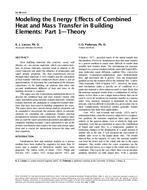Description
Most building materials like concrete, wood, wall finishes, etc., are porous materials, which can contain moisture. In porous materials, moisture tends to migrate to the cooler material side under the influence of temperature and vapor density gradients. The heat transmission process through moist materials is very complex and the calculation of heat transfer with heat conduction theory alone is just an approximation. To determine the contribution of the moisture capacitance in the building, an analysis that takes into account simultaneous diffusion of heat and mass in the building elements is required. This paper uses the evaporation-condensation theory to develop the combined heat and mass transfer models with vapor adsorption using moisture transfer functions. Moisture transfer functions are analogous to conduction transfer functions that have been used in building simulations for years. This paper shows how current energy analysis programs can be expanded to incorporate the moisture effects in envelope elements by extending the conduction transfer function formulation to moisture transfer functions. The analysis takes into account the vapor adsorption/desorption and diffusion in composite building elements. Vapor adsorption is one of the primary mechanisms that couples the mass and energy equations and is crucial for interactions between the mass and heat equations.
Units: SI
Citation: Symposium, ASHRAE Transactions, vol. 105, pt. 2, Seattle 1999
Product Details
- Published:
- 1999
- Number of Pages:
- 13
- File Size:
- 1 file , 1.1 MB
- Product Code(s):
- D-7456




